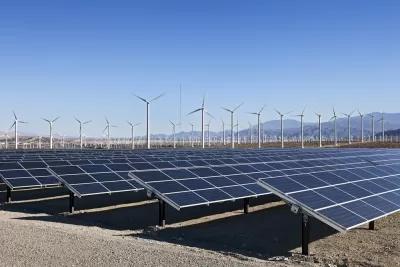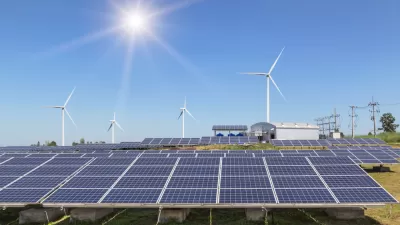To stave off rolling blackouts during a record heat wave, California relied on dramatic conservation by households and a growing renewable energy sector.

Renewable energy commitments aren’t to blame for the strain on California’s power grid, writes Jonathan Thompson in a piece for High Country News. Rather, the warming climate—caused by burning fossil fuels—is the real culprit, and shifting to renewables is one of the only ways to fight it.
On September 6, California utilities urged households to conserve energy to avoid rolling blackouts, even as temperatures across the state hit record highs. “Still, for most of that afternoon, all went smoothly on the California grid because solar and wind output was so high, offsetting about 30% of the total demand.”
In fact, Thompson writes, thanks in large part to a dramatic reduction in demand by California residents that day, “There were no statewide rolling outages, the grid stood up to extreme weather, and fossil fuel advocates’ attempt to politically weaponize the predicted blackouts fell flat.”
Thompson lists some key points to remember, “especially when you hear rhetoric about this near-miss being the result of green energy policies.” For example, California’s growing battery storage capacity and the more widespread adoption of electric vehicles, which can put power back into the grid, will enhance the stability of the state’s power supply. Ultimately, Thompson notes, the success of the state’s efforts to keep the lights on on September 6 hinged on the willingness of individual Californians to conserve during a crucial time.
FULL STORY: The Green New Deal didn’t crash California’s grid

Study: Maui’s Plan to Convert Vacation Rentals to Long-Term Housing Could Cause Nearly $1 Billion Economic Loss
The plan would reduce visitor accommodation by 25,% resulting in 1,900 jobs lost.

North Texas Transit Leaders Tout Benefits of TOD for Growing Region
At a summit focused on transit-oriented development, policymakers discussed how North Texas’ expanded light rail system can serve as a tool for economic growth.

Why Should We Subsidize Public Transportation?
Many public transit agencies face financial stress due to rising costs, declining fare revenue, and declining subsidies. Transit advocates must provide a strong business case for increasing public transit funding.

How Community Science Connects People, Parks, and Biodiversity
Community science engages people of all backgrounds in documenting local biodiversity, strengthening connections to nature, and contributing to global efforts like the City Nature Challenge to build a more inclusive and resilient future.

Alabama: Trump Terminates Settlements for Black Communities Harmed By Raw Sewage
Trump deemed the landmark civil rights agreement “illegal DEI and environmental justice policy.”

Dear Tesla Driver: “It’s not You, It’s Him.”
Amidst a booming bumper sticker industry, one writer offers solace to those asking, “Does this car make me look fascist?”
Urban Design for Planners 1: Software Tools
This six-course series explores essential urban design concepts using open source software and equips planners with the tools they need to participate fully in the urban design process.
Planning for Universal Design
Learn the tools for implementing Universal Design in planning regulations.
City of Santa Clarita
Ascent Environmental
Institute for Housing and Urban Development Studies (IHS)
City of Grandview
Harvard GSD Executive Education
Toledo-Lucas County Plan Commissions
Salt Lake City
NYU Wagner Graduate School of Public Service





























